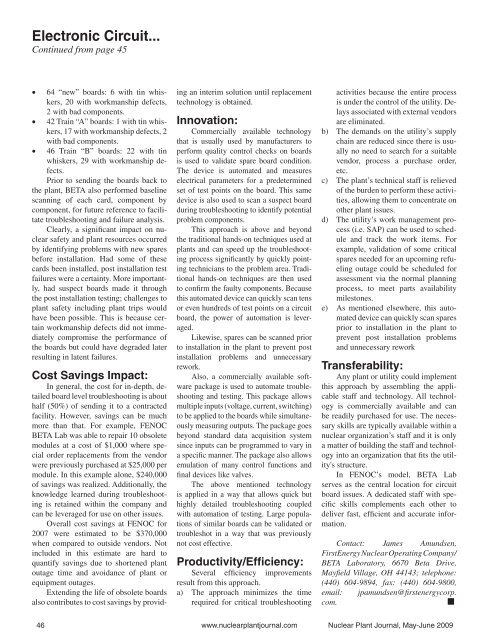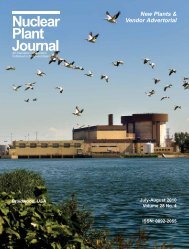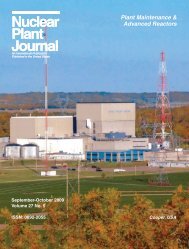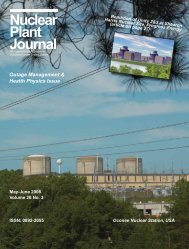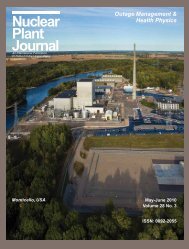Nuclear Plant Journal Outage Management ... - Digital Versions
Nuclear Plant Journal Outage Management ... - Digital Versions
Nuclear Plant Journal Outage Management ... - Digital Versions
Create successful ePaper yourself
Turn your PDF publications into a flip-book with our unique Google optimized e-Paper software.
Electronic Circuit...<br />
Continued from page 45<br />
• 64 “new” boards: 6 with tin whiskers,<br />
20 with workmanship defects,<br />
2 with bad components.<br />
• 42 Train “A” boards: 1 with tin whiskers,<br />
17 with workmanship defects, 2<br />
with bad components.<br />
• 46 Train “B” boards: 22 with tin<br />
whiskers, 29 with workmanship defects.<br />
Prior to sending the boards back to<br />
the plant, BETA also performed baseline<br />
scanning of each card, component by<br />
component, for future reference to facilitate<br />
troubleshooting and failure analysis.<br />
Clearly, a significant impact on nuclear<br />
safety and plant resources occurred<br />
by identifying problems with new spares<br />
before installation. Had some of these<br />
cards been installed, post installation test<br />
failures were a certainty. More importantly,<br />
had suspect boards made it through<br />
the post installation testing; challenges to<br />
plant safety including plant trips would<br />
have been possible. This is because certain<br />
workmanship defects did not immediately<br />
compromise the performance of<br />
the boards but could have degraded later<br />
resulting in latent failures.<br />
Cost Savings Impact:<br />
In general, the cost for in-depth, detailed<br />
board level troubleshooting is about<br />
half (50%) of sending it to a contracted<br />
facility. However, savings can be much<br />
more than that. For example, FENOC<br />
BETA Lab was able to repair 10 obsolete<br />
modules at a cost of $1,000 where special<br />
order replacements from the vendor<br />
were previously purchased at $25,000 per<br />
module. In this example alone, $240,000<br />
of savings was realized. Additionally, the<br />
knowledge learned during troubleshooting<br />
is retained within the company and<br />
can be leveraged for use on other issues.<br />
Overall cost savings at FENOC for<br />
2007 were estimated to be $370,000<br />
when compared to outside vendors. Not<br />
included in this estimate are hard to<br />
quantify savings due to shortened plant<br />
outage time and avoidance of plant or<br />
equipment outages.<br />
Extending the life of obsolete boards<br />
also contributes to cost savings by providing<br />
an interim solution until replacement<br />
technology is obtained.<br />
Innovation:<br />
Commercially available technology<br />
that is usually used by manufacturers to<br />
perform quality control checks on boards<br />
is used to validate spare board condition.<br />
The device is automated and measures<br />
electrical parameters for a predetermined<br />
set of test points on the board. This same<br />
device is also used to scan a suspect board<br />
during troubleshooting to identify potential<br />
problem components.<br />
This approach is above and beyond<br />
the traditional hands-on techniques used at<br />
plants and can speed up the troubleshooting<br />
process significantly by quickly pointing<br />
technicians to the problem area. Traditional<br />
hands-on techniques are then used<br />
to confirm the faulty components. Because<br />
this automated device can quickly scan tens<br />
or even hundreds of test points on a circuit<br />
board, the power of automation is leveraged.<br />
Likewise, spares can be scanned prior<br />
to installation in the plant to prevent post<br />
installation problems and unnecessary<br />
rework.<br />
Also, a commercially available software<br />
package is used to automate troubleshooting<br />
and testing. This package allows<br />
multiple inputs (voltage, current, switching)<br />
to be applied to the boards while simultaneously<br />
measuring outputs. The package goes<br />
beyond standard data acquisition system<br />
since inputs can be programmed to vary in<br />
a specific manner. The package also allows<br />
emulation of many control functions and<br />
final devices like valves.<br />
The above mentioned technology<br />
is applied in a way that allows quick but<br />
highly detailed troubleshooting coupled<br />
with automation of testing. Large populations<br />
of similar boards can be validated or<br />
troubleshot in a way that was previously<br />
not cost effective.<br />
Productivity/Efficiency:<br />
Several efficiency improvements<br />
result from this approach.<br />
a) The approach minimizes the time<br />
required for critical troubleshooting<br />
b)<br />
c)<br />
d)<br />
activities because the entire process<br />
is under the control of the utility. Delays<br />
associated with external vendors<br />
are eliminated.<br />
The demands on the utility’s supply<br />
chain are reduced since there is usually<br />
no need to search for a suitable<br />
vendor, process a purchase order,<br />
etc.<br />
The plant’s technical staff is relieved<br />
of the burden to perform these activities,<br />
allowing them to concentrate on<br />
other plant issues.<br />
The utility’s work management pro-<br />
cess (i.e. SAP) can be used to schedule<br />
and track the work items. For<br />
example, validation of some critical<br />
spares needed for an upcoming refueling<br />
outage could be scheduled for<br />
assessment via the normal planning<br />
process, to meet parts availability<br />
milestones.<br />
As mentioned elsewhere, this auto-<br />
mated device can quickly scan spares<br />
prior to installation in the plant to<br />
prevent post installation problems<br />
and unnecessary rework<br />
e)<br />
Transferability:<br />
Any plant or utility could implement<br />
this approach by assembling the applicable<br />
staff and technology. All technology<br />
is commercially available and can<br />
be readily purchased for use. The necessary<br />
skills are typically available within a<br />
nuclear organization’s staff and it is only<br />
a matter of building the staff and technology<br />
into an organization that fits the utility's<br />
structure.<br />
In FENOC’s model, BETA Lab<br />
serves as the central location for circuit<br />
board issues. A dedicated staff with specific<br />
skills complements each other to<br />
deliver fast, efficient and accurate information.<br />
Contact: James Amundsen,<br />
FirstEnergy <strong>Nuclear</strong> Operating Company/<br />
BETA Laboratory, 6670 Beta Drive,<br />
Mayfi eld Village, OH 44143; telephone:<br />
(440) 604-9894, fax: (440) 604-9800,<br />
email: jpamundsen@fi rstenergycorp.<br />
com.<br />
<br />
46 www.nuclearplantjournal.com <strong>Nuclear</strong> <strong>Plant</strong> <strong>Journal</strong>, May-June 2009


